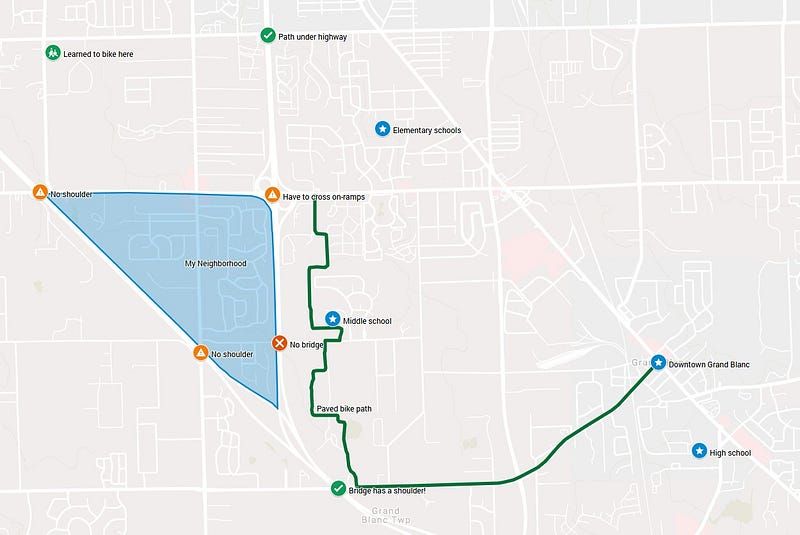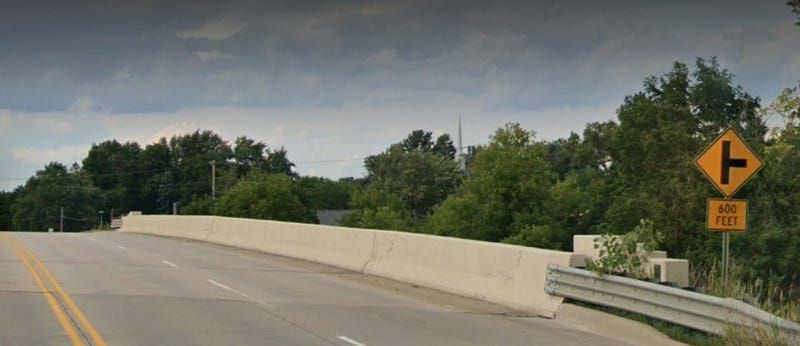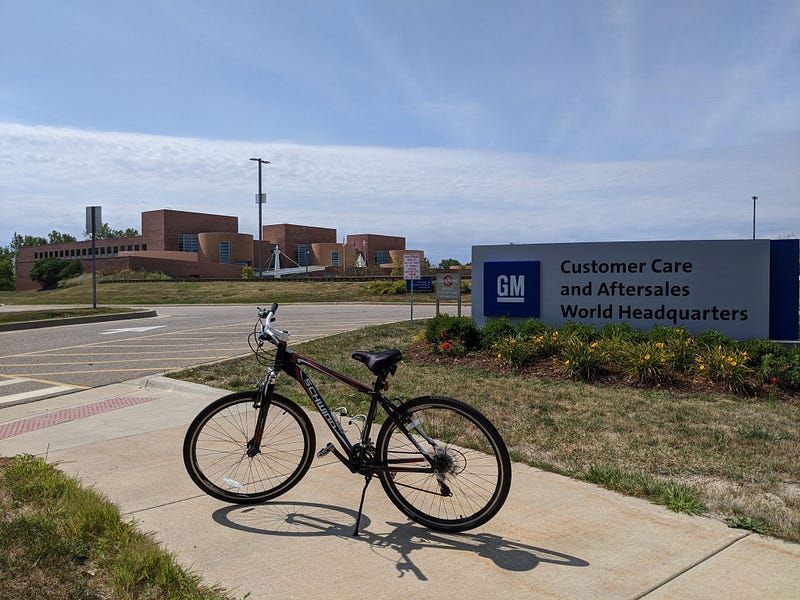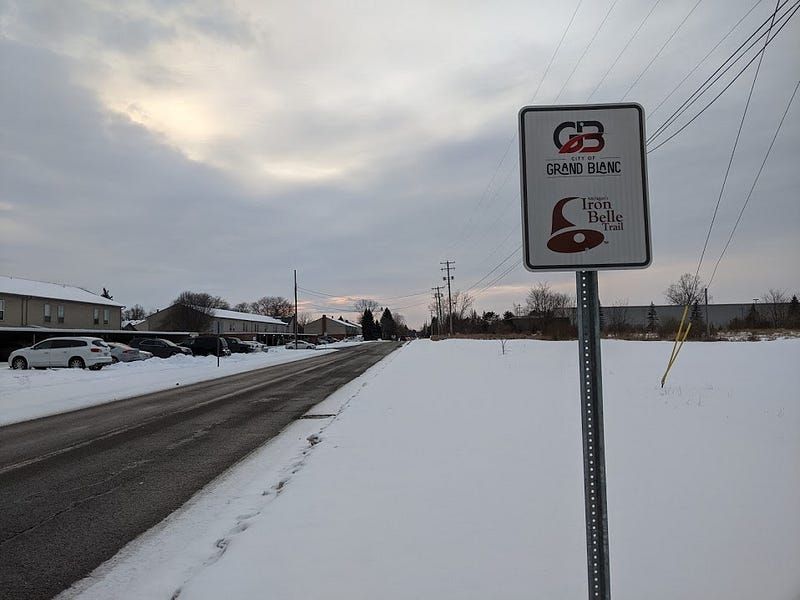Biking as a Kid: Living “Off the Grid”

In my neighborhood, going for a bike ride means getting in the car. It doesn’t have to.
I grew up in Grand Blanc, a suburb of Flint in Genesee County, Michigan. Living just outside the Vehicle City meant my family’s life largely revolved around cars; my dad worked at a molding plant that sold parts to GM, and much of our home was decorated in Michigan automotive memorabilia.
But like most other kids, there came a time when my sister and I were taught how to bike. Eventually, after countless wobbly circles around our local junior high parking lot, the training wheels came off and we first asked our parents: “Can we go on a bike trip?”
“Sure!” They said. “This weekend we’ll load them up in the car and drive to the park.”
Just for fun?
This shaped my view on bicycling as a kid. It was purely recreational, never spontaneous or a means of transportation. Biking trips were planned days in advance, and aside from rail-trails in distant cities such as Midland, never with a specific destination in mind. We were just “on a ride.”
Why was this? Because there was no safe way for us to get anywhere worth going unless we were in a car.

The Bicentennial Park Path, Grand Blanc Township’s most prolific biking trail, would’ve been within easy reach as a kid growing up if not for the highway configuration “landlocking” my neighborhood. If I wanted to bike in GB, I had to drive there first.
My childhood home is on the Grand Blanc Township border off of Fenton Road, a major four-lane thoroughfare with heavy traffic traveling between three major expressways: I-75, I-475, and US-23. The road has no sidewalks. Even riding around in our subdivisions — the only streets we could safely reach on foot — meant walking our bikes through grass along the side of the road, which would often stay damp days after a heavy rain due to stormwater runoff. It wasn’t designed with pedestrians in mind.

Try to safely cross this blind overpass with no shoulder on a bike.
Actually reaching downtown Grand Blanc by bike was impossible. My stretch of Fenton was bounded on three sides by the expressways: Try to travel south along Fenton or east along Hill and you reach an impassable bridge. We were “landlocked.”
A “Landlocked” Neighborhood
Fast forward to eighth grade. The Bicentennial Park Pathway, originally paved along Grand Blanc Road to connect the park to downtown, was extended to great fanfare north of the park, around West Middle School, and all the way to GMSPO, a large corporate office building on the north side of the township. I was quite familiar with this building; it was two minutes from my house, and visible out the window from some of my classrooms at GBWMS.

GM Customer Care World Headquarters, known to most locals by its former name: Service Parts Operations, or GMSPO. The Bicentennial Park Pathway begins here.
At the end of the year, our teachers held a special event for us. We all walked down this new pathway and celebrated the end of junior high with a picnic lunch and friendly sports. Some students who lived nearby brought their bikes and rolled alongside us. They talked about how they watched the township pave the trail, and often used it to ride into the park from their homes after school.
My house was just over a mile away from the school. I would’ve loved to do this, but there was a snag: West Middle School is on Reid Road east of 475, and its intersection with Fenton Road is west of the expressway. When Reid was bisected by 475 in the 1970s, no bridge was built — all that was placed was a big “Road Ends” sign with a view of traffic whizzing by at 70 miles per hour. Any possible alternative route would’ve meant biking several miles out of the way.
This was the moment I started to realize what I was missing. Why could they get someplace useful while I was trapped?
A means of transportation

The Iron Belle Trail is Michigan’s longest biking route, which makes use of public roadways including Reid Road in the City of Grand Blanc.

There is no complete sidewalk between Grand Blanc High School and NCG Trillium, our local cinema. Determined students have walked along the road after class on a Friday to see a movie with friends. Missing segments are in red.
The first step in creating a more connected community is recognizing where the missing links are. The Reid Road example from my own childhood is just one of many. Take another from my high school years: the short mile walk between Grand Blanc High School and NCG Trillium, our movie theater.
It’s a similar story. You‘re walking on grass along a busy road. But students do it. The desire is there; most high schoolers don’t have their driver’s licenses yet, and even if they do, a paid permit is required to park at the school.
Creating a fully walkable and bikeable community will help future generations of kids feels more connected to each other and their communities. They’ll see walking and cycling as viable ways to get around their own neighborhood, not just something you travel to another city to do for fun.
Moving Forward

A newer bridge on Baldwin Road intentionally constructed with a walkway for a planned sidewalk development. We need more future-proofing like this!
I don’t believe Grand Blanc is a community with an intention of being hostile to those getting around without driving. We have beautiful trails like Bicentennial and the Physicians Park loop downtown. The Saginaw Street corridor itself is already walkable with new small-footprint businesses opening every year. We have fixed-route public transportation connections to Flint and Metro Detroit. We just have to do a better job of connecting all of the city and township’s residents to the areas that are already built well.
We have to reconnect the grid. If that means a grassroots campaign pushing for sidewalks along every major road, then let’s band together and get it done. The Grand Blanc Grid is doing just that.
While I may have grown up and started living on my own as a college student in Metro Detroit, Grand Blanc is my home. It’s where I’ve spent most of my life, and I want to see it improve for current residents and future generations of kids. Strengthen those non-motorized connections and make my childhood community the strong town I know it can be.